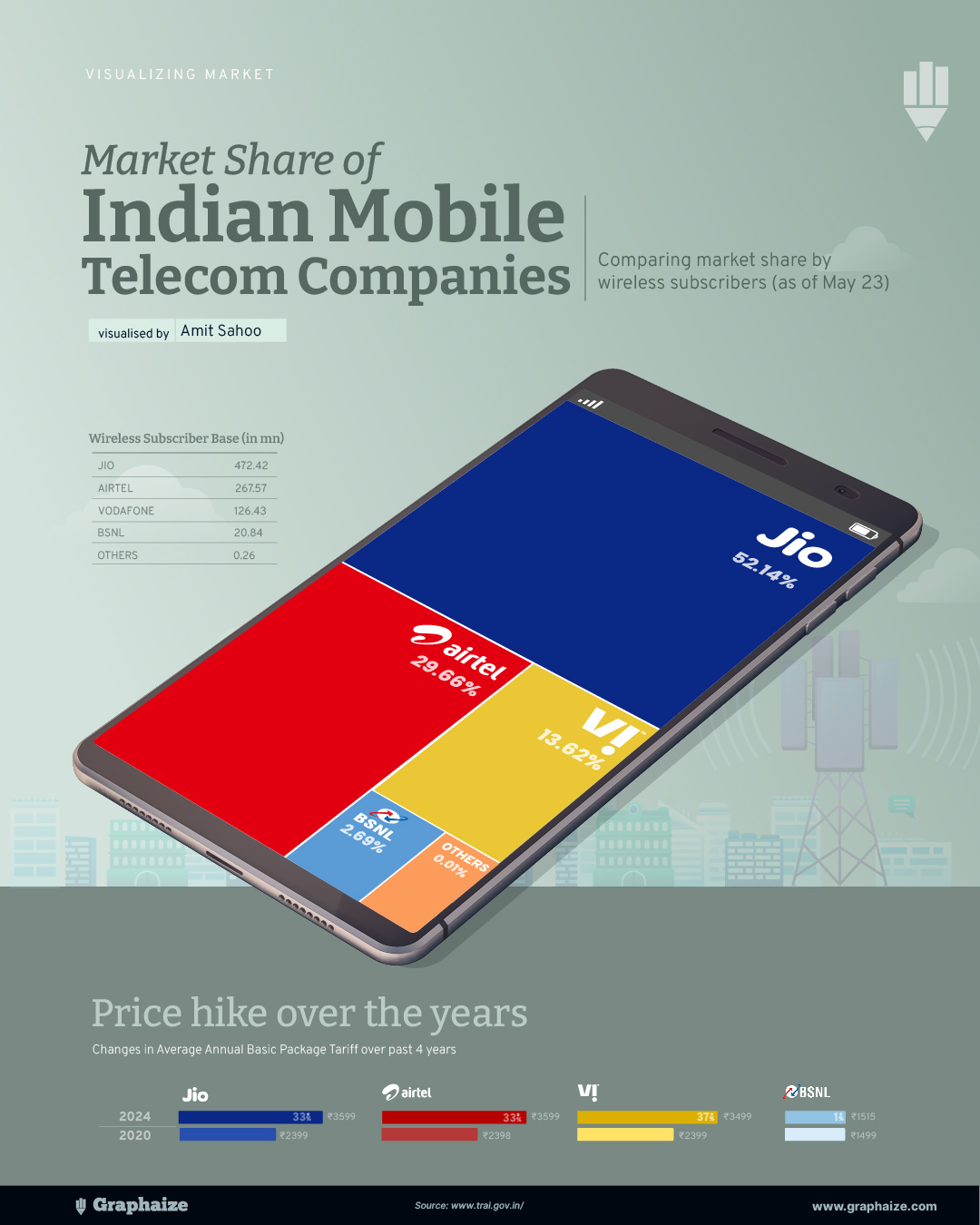
The Indian mobile telecom market is a bustling and competitive landscape with key players constantly vying for dominance. In 2022, the market experienced a significant shift. In 2024 as we are writing this article, Jio is leading at 52.14%, Airtel at 29.66%, Vodafone Idea at 13.62%, BSNL at 2.69%, and others at 0.01%. This intense competition drives innovation and enhances service quality for millions of users. Our comprehensive analysis and infographics provide a detailed overview of market share trends, subscriber growth, and price hike performance. By examining these statistics, we can better understand the strategies and factors influencing the telecom sector.
How Jio disrupted the Indian consumer market
Reliance Jio, launched in 2016, completely transformed the Indian consumer market by revolutionizing the telecommunications industry. Before Jio’s entry, data services were costly, and mobile internet penetration was relatively low. Jio changed the game by offering free voice calls and extremely affordable data plans, making internet access available to millions.
Their disruptive strategies included aggressive pricing models, which forced competitors to lower their prices, thus making data services more affordable nationwide. By investing heavily in 4G LTE infrastructure, Jio ensured high-speed internet access even in rural areas, boosting internet penetration and digital inclusion.
Moreover, Jio introduced a range of innovative digital services, such as JioTV, JioCinema, and JioSaavn, creating a comprehensive digital ecosystem that enhanced user experience and engagement. Offering free Jio SIM cards and introductory free data services helped them rapidly grow their user base, reaching over 100 million subscribers in just 170 days.
Massive investments in spectrum and technology also created a robust network, ensuring reliable and wide-reaching service. Jio’s entry reshaped the Indian telecom landscape, driving down costs, increasing competition, and significantly enhancing digital connectivity across the country.
Changes in tariffs by Jio
In 2024, leading Indian telecom companies, including Reliance Jio, Airtel, and Vodafone Idea, implemented a notable price hike, raising average tariffs by 20-25%. The infographics highlight price hikes by each of the major operators. This move has sparked widespread discussion among users and industry analysts.
Several factors contribute to this increase. Firstly, the telecom sector faces escalating operational costs, such as spectrum acquisition, network maintenance, and the rollout of 5G infrastructure. These investments are crucial for enhancing service quality and expanding network coverage, necessitating a price adjustment.
Secondly, the industry has endured prolonged periods of intense competition and low tariffs, which have strained profitability. By raising prices, telecom companies aim to improve their financial health and fund future technological advancements.
Other telecom companies have reacted by following suit or considering similar price adjustments. Airtel and Vodafone Idea have supported the move, emphasizing the importance of sustainable pricing for maintaining high-quality services and enabling further innovation.
User reactions have been mixed. Some consumers understand the necessity of the hike, acknowledging the need for better service quality and network reliability. However, others are concerned about affordability, particularly for low-income users, and the overall impact on their monthly expenses.
The 2024 telecom price hike reflects the industry’s efforts to balance financial sustainability with the commitment to providing cutting-edge services to a rapidly growing user base.
BSNL gains subscribers amidst private telco tariff hikes
In 2024, Bharat Sanchar Nigam Limited (BSNL) saw a notable increase in subscribers as private telecom companies like Reliance Jio, Airtel, and Vodafone Idea raised their tariffs by 20-25%. From the above data visual we can see the contrast between the increments. This shift reflects a mix of factors driving consumers towards the state-owned provider.
BSNL’s lower-cost plans became more attractive to budget-conscious users, particularly those in rural and semi-urban areas. The affordability of BSNL’s offerings provided a compelling alternative to the higher-priced plans from private telcos.
BSNL has made significant strides in upgrading its infrastructure, expanding its 4G services, and improving overall service reliability. These enhancements have made it a more viable option for consumers seeking dependable connectivity without the higher costs.
Through loyalty programs and promotional offers, BSNL has successfully retained existing customers while attracting new ones. These initiatives have built consumer trust and perceived value.
Despite these gains, BSNL still faces challenges, such as limited urban presence and slower rollout of 5G compared to private competitors. Some users may experience occasional service disruptions or slower internet speeds in certain areas.
The Indian mobile telecom market continues to evolve with fierce competition among key players. Jio’s disruptive strategies, the 2024 price hike, and BSNL’s subscriber growth amidst tariff hikes are significant developments shaping the industry. By understanding these trends and factors, consumers and industry stakeholders can better navigate the dynamic telecom landscape in India.
Unlock the power of captivating visuals with our seasoned expertise! With 7 years of crafting compelling visual content, we’re ready to elevate your brand’s story. From stunning graphics to mesmerizing animations, we bring your vision to life. Let’s create engaging visuals that resonate with your audience and leave a lasting impression. Partner with us today for an unforgettable visual journey!
